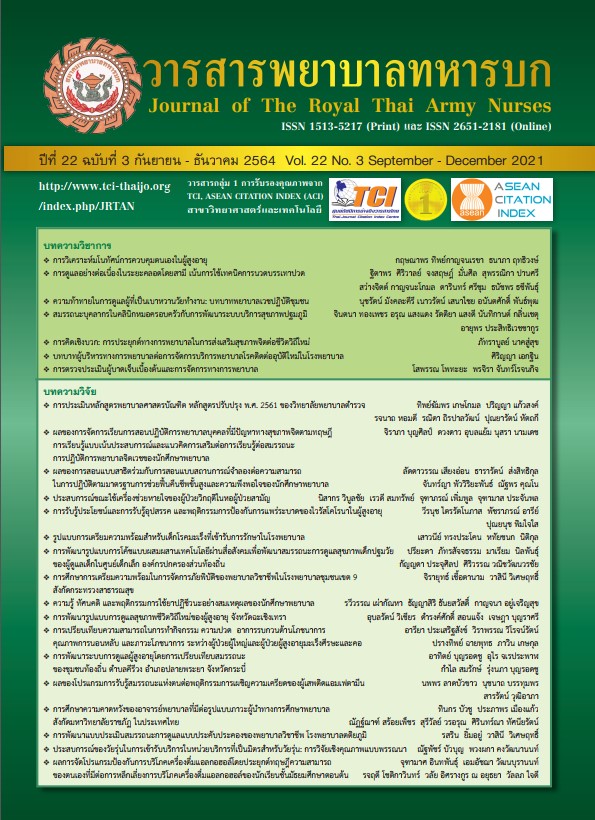Learning Management on Sex Education using Love Model for Reducing Risk Sexual Behaviors to Adolecents
Keywords:
Love Model, Sex risk behaviors, AdolescenceAbstract
This quasi-experimental research aimed to 1.) compare the mean scores of the sexual risk behaviors and the learning achievement before and after treatment between the experimental group and the controlled group 2.) compare the mean scores of the experimental group and the controlled group before and after treatment and 3.) compares the difference of the mean scores of the experimental group before and after treatment and 4 weeks after treatment in sexual risk behaviors and learning achievement in sex education The sample was selected by the purposive sampling method consisting of 70 grade 7 students 1: an experimental group of 35 students and a controlled group of 35 students. The experimental group received 8 sex education learning management by using LOVE Model. The sexual risk behaviors test and the sex education learning achievement test Were enployed. The data obtained were analyzed by using frequency, Standard Deviation, t-test, One-way ANOVA and LSD. The findings were as follows:1.) After treatment, the experimental group had the high mean score of sexual risk behaviors and were better than the controll group in statistically significant at .05. level 2.) After treatment, the experimental group had the higher mean score of learning achievement in sex education than before treatment and ware higher than the controll group in statistically significant at .05. level 3.) The mean scores of sex risk behaviors and learning achievement in sex education were not different between 4 weeks after treatment and after treatment.
Downloads
References
Department of Disease Control. Sexual morbidity rates in teens and young people aged 15-24 year; 2010. (in Thai)
Department of Disease Control. Percentage of condom use and contraception using reliable methods; 2011. (in Thai)
Department of Disease Control. The average age of first sexual intercourse and sexual relations; 2017. (in Thai)
Department of mental Health. Smart Teen Love Say + Play. Bangkok :Uranus Group ; 2014. (in Thai)
Ministry of Education. Basic Education Core Curriculum B.E. 2008. Bangkok: Agricultural Cooperative Federation of Thailand. Limited ; 2008. (in Thai)
Aimutcha W. Development Research of LOVE MODEL for Enhancing Comprehensive. Humanization : A Research Program for Higher Education Students. Bangkok:Faculty of Education Chulalongkorn University; 2018. (in Thai)
Polit D.F, Hungler B.P. Nursing Research Principles and Methods. Philadelphia PA, JB Lippincott ;1995.
Likert, R. A. Technique for the Measurement of Attitude. Archives Psychological 1995;(3) : 42-48.
Aimutcha W. A manual of Love Model application. model for enhancing comprehensive humanization. Bangkok: Odeon store; 2014. (in Thai)
Kaewviengdach H. Factors Associated with Sexual Risk Behaviours Among Secondary School Students in Nakhon Phanom Province J Royal Thai Army Nurse. 1; 17 (3):77-168. (in Thai)
Davey, S. G. & Susser, E. Zena Stein. Mervyn Susser and epidemiology observation, causation and action : International Journal Epidemio; 2002.
Downloads
Published
How to Cite
Issue
Section
License
บทความหรือข้อคิดเห็นใดใดที่ปรากฏในวารสารพยาบาลทหารบกเป็นวรรณกรรมของผู้เขียน ซึ่งบรรณาธิการหรือสมาคมพยาบาลทหารบก ไม่จำเป็นต้องเห็นด้วย
บทความที่ได้รับการตีพิมพ์เป็นลิขสิทธิ์ของวารสารพยาบาลทหารบก
The ideas and opinions expressed in the Journal of The Royal Thai Army Nurses are those of the authors and not necessarily those
of the editor or Royal Thai Army Nurses Association.






